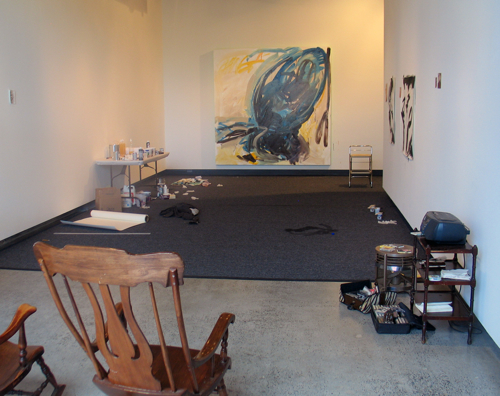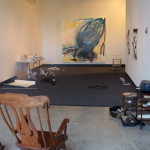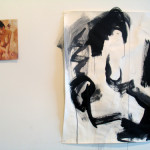Two recently opened shows in Portland, Oregon have positioned traditional and craft skills as a series of political acts: gestures that challenge convention and seek to re-affirm new roles within the discourse of art. While Timothy Scott Dalbow's exhibition at the New American Art Union identifies itself as an "act of reversal" or "critique of post-studio practice", it relies on the category of "post-studio" to locate itself. On the other end, the Museum of Contemporary Craft's "Gestures of Resistance" relies on an acceptance, or reverence, for post-studio practice, utilizing craft's history of politics as an occasion for performance that will, hopefully, challenge prevailing authority and institutional practice.
For the exhibition "I Don't Know Anyone in Paris", Timothy Scott Dalbow will use the NAAU gallery as his painting studio. Throughout the 5-week exhibition, Dalbow will continue his painting practice (apparently mostly a night one) as he sees fit, displaying the evidence of his working process along the way. My visit to the gallery saw stacks of simple black, grey and white gestural works on paper - satisfying derivatives of Franz Kline - as well as clippings of soft-core porn that were pinned to the wall above a table where the paintings were stacked (potential source material?). Functional, grey-colored carpeting designated the main painting area and the back wall featured the largest canvas in the gallery. The drips from Dalbow's thin washes of paint from his canvas onto the carpeted floor below create a closeness to his painting technique. "Expressive" and drippy gestures on canvas, paint rags with multi-colored stains, along with the familiar stench of oil paint gave the gallery the authentic aura of an artist's studio. Outfitted with two rocking chairs in the back of the gallery, visitors could presumably watch the artist at work, so long as he is there when you happen to visit.
A telling sentence from the gallery's press release states: "Evolving daily, this exhibit feels necessary in this period of contemporary art where shrinking budgets and post-studio movements increasingly raise the question: why is art important and why are art objects of such great value." They imply an interesting idea that the only way to answer these questions is to "evolve daily," to perform the question publicly. The tacit implication is that Timothy Scott Dalbow and NAAU believe a return to the core of art making in the form of "the painter" - the most celebrated, clichéd and important figure the western art world has seen – possesses some traction. The gamble of the show posits that in the figure of the painter, one can find a workable model to some fundamental questions about art: Why is it important and why is it worth so much.
Has post-studio practice overtaken the importance of painting? This exhibition seems to imply as much. If "traditional" studio practice is to reassert itself, what exactly will distinguish that practice? One would hope these questions would be grappled with in the form of Dalbow's paintings, but it remains unclear what his funky abstractions contribute to the dialog. Rather, the format of the exhibition –NAAU's "residency" series, which will continue with Gabriel Liston after Dalbow - treats the idea of "the painter" as a readymade - an entity to be inserted, once again and with hope for relevance, into the narrative of contemporary art.
The Museum of Contemporary Craft’s "Gestures of Resistance," a six-month exhibition co-curated by the Boston-based Judith Leeman and Chicago-based Shannon Stratton, is also laced with political programming strategies. Each of the eight artists in the exhibition will similarly take up residence in the MoCC galleries, with each one "remaking the space to suit their own purposes." Not to be confined to a live studio performance, many of the artists will utilize the neighborhoods and streets of Portland to create, "context-savvy crafting, hierarchical mischief-making, and cultural re-scripting." Like NAAU's hope for restoring a new position for painting, MoCC seeks to revitalize craft by embracing its traditional categories but infusing them with new strategies of post-studio practice.
For her contribution to the exhibition, Anthea Black, a Canadian printmaker known for her subversive postering campaigns, will recruit queer youth to deploy her two-sided poster prints across Portland. Carole Lung will "address herself to the specifics of Portland's garment culture - hacking a Columbia Sportswear design for rain gear and sewing five sets of the garment using a bicycle-powered sewing machine." Other artists will work across Portland or customize the gallery in some fashion, but the primary similarities amongst all the artists is that they employ some form of traditional craft – sewing, printmaking, ceramics, etc. – and then perform that craft in such a way that it reflects a social inequality inherent in the craft or utilize that craft to "slowly" and actively "politicize" their activities. The most promising looks to be Theaster Gates, who has previously invented personas and histories for his ceramic objects, in part because he could not find a proper lineage without creating a false one.
Since both exhibitions have the artist(s) perform and reconfigure space throughout the length of the exhibition, the results from each will, theoretically, be felt and realized over time and with anticipated mixed results. This unpredictability yields both the risk and potential rewards for such a program. Criticism of either exhibition can thus be endlessly deferred, or forever unrealized, because it will constantly waver as to when one sees the work and in what stage. This de-stabilization of the art object and exhibition becomes a definite and welcome way to create fluid, less fixed meanings for works of art. On the other hand, both exhibitions assert a programming statement that might rival any of the artists’ contributions. In this instance, the mediation of artistic strategy is perhaps the strongest voice present, a voice generated by the many conversations and dialogs that give institutional framework its structure and authority. If one is to believe that post-studio practice has become the dominant mode of artistic production, it should also be questioned whether the curatorial/programming strategies that privilege these projects have taken the presumed status of being inherently critical and progressive. Expanded institutional framework has allowed the performance of protest to become very comfortable within its doors - a position that makes the resisting feel a bit mannered, almost formal and complicit in its political potential.
- Installation shot of works by Timothy Scott Dalbow on “Day 1” at the New American Art Union.
- Detail of works by Timothy Scott Dalbow on display during Day 10 at the New American Art Union.
The New American Art Union
The Museum of Contemporary Craft
"Timothy Scott Dalbow: I Don't Know Anyone in Paris" will be on view at the New American Art Union from February 14th - March 28th, 2010.
"Gestures of Resistance" will be on view at the Museum of Contemporary Craft from January 26th - June 26th, 2010.
All images are courtesy of the artists and the Museum of Contemporary Craft and the New American Art Union.






